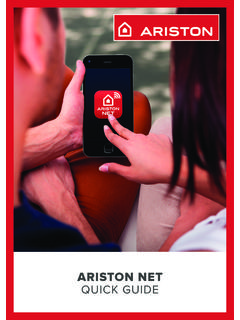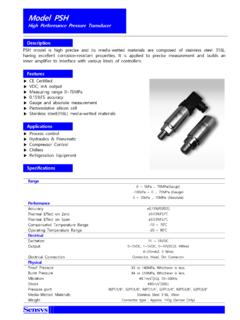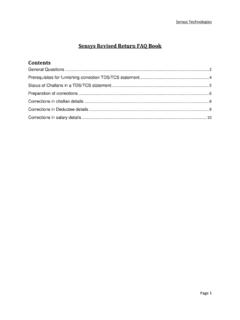Transcription of Lossy Links, Low Power, High Throughput - …
1 Lossy Links, Low Power, High ThroughputSimon Institute of Computer ScienceBox 1263, SE-16429 Kista, SwedenAbstractAs sensor networks move towards general-purpose low-power wireless networks, there is a need to support bothtraditional low-data rate traffic and high- Throughput trans-fer. To attain high Throughput , existing protocols monop-olize the network resources and keep the radio on for allnodes involved in the transfer, leading to poor energy effi-ciency. This becomes progressively problematic in networkswith packet loss, which inevitably occur in any real-worlddeployment.
2 We presentburst forwarding, a generic packetforwarding technique that combines low power consumptionwith high Throughput for multi-purpose wireless forwarding uses radio duty cycling to maintain a lowpower consumption, recovers efficiently from interference,and inherently supports both single streams and experimentally evaluate our mechanism under heavy in-terference and compare it to PIP, a state-of-the-art sensornetbulk transfer protocol. Burst forwarding gracefully adaptsradio duty cycle both to the level of interference and to traf-fic load, keeping a low and nearly constant energy cost perbyte when carrying TCP and Subject [Computer-Communication Networks].
3 Net-work Architecture and Design Wireless CommunicationGeneral TermsDesign, Experimentation, PerformanceKeywordsSensor Network, Energy Efficiency, Interference1 IntroductionAs sensor networks move from single-purpose, homo-geneous systems towards multi-purpose, heterogeneous sys-tems, supporting multiple types of protocol is of increasingimportance. Many different protocols have been developed,Permission to make digital or hard copies of all or part of this work for personal orclassroom use is granted without fee provided that copies are not made or distributedfor profit or commercial advantage and that copies bear this notice and the full citationon the first page.
4 To copy otherwise, to republish, to post on servers or to redistributeto lists, requires prior specific permission and/or a 11,November 1 4, 2011, Seattle, WA, 2011 ACM 978-1-4503-0718-5/11/11 ..$ have typically been considered in isolation. At one ex-treme, low power, low data rate data collection protocolshave seen much attention [10, 23], but have a focus on lowpower consumption with little regard for Throughput . At theother extreme, bulk transport protocols such as Flush [14]and PIP [27] focus only on Throughput with no regard forlow power consumption.
5 Yet the two extremes must be com-bined in emerging bulk transfer protocols [14, 24, 27] monopolizemulti-hop path and disable radio duty cycling to achieve highthroughput. We argue that multi-purpose low power net-works need a generic forwarding technique able to handlecross-traffic while maintaining low power presentburst forwarding, a generic forwarding tech-nique intended to allow high Throughput data transport withlow power consumption in Lossy wireless networks. Burstforwarding groups multiple packets into bursts that are trans-mitted over each hop with a stubborn link layer performingretransmissions on millisecond time scales.
6 Bursts are coor-dinated across multiple hops using a two-level retransmis-sion scheme and multi-channel operation. The nodes useradio duty cycling to keep the radio off more than 99% ofthe time. They wake up periodically to receive long burstsof data, store them in flash memory, and forward them tothe next hop. The system adapts gracefully to interferencethanks to retransmissions operating at both granularities offrames and bursts, handling both isolated losses and longer-lasting forwarding is a generic mechanism that is not tiedto any protocol: in this paper we used it below both bulktransfer, sensornet data collection, and IPv6.
7 We use burstforwarding to carry TCP traffic over low-power wireless net-works with high loss rates, demonstrating a nearly constantenergy cost per byte, even during heavy paper makes three contributions. First, we showthat the combination of techniques in burst forwarding pro-vides high Throughput and low power consumption in multi-purpose networks even during severe radio interference. Sec-ond, we propose and evaluate a two-level retransmissionmechanism addressing isolated losses, high-frequency inter-ference as efficiently low-frequency interference.
8 Third, weleverage burst forwarding to bring TCP to low-power wire-less networks and show that a constant energy cost per bytecan be reached under increasing radio OD02468101214 Throughput (kB/s)upper boundprotocolsFigure 1. The Throughput of existing high-throughputtransportmechanismsforlow -powernetworks:Flush [14], PIP [27], and Osterlind and Dunkels( OD) [24]. OD reaches 97% of the theoretical is the fastest fully-fledged protocol kB/s, or 52% of the upper paper is organized as follows: Section 2 motivatesthe need for general-purpose forwarding in low-power sen-sornets.
9 Section 3 presents the design of burst forward-ing. Section 4 discusses the application of burst forward-ing to TCP transport in low-power wireless networks. Sec-tion 5 presents implementation aspects of burst 6 evaluates burst forwarding in terms of energy-efficiency and Throughput . It characterizes its behavior whenfacing interference and when handling cross-traffic. Sec-tion 7 addresses the support of TCP on top of burst forward-ing, demonstrating the good interaction of rate control andradio duty cycling. We present the related work in Section 8,and conclude in Section A Case for General-Purpose Forwarding inLow-Power Wireless NetworksWe believe that existing high- Throughput mechanisms arenot in line with the current trend of multi-purpose sensor net-works and that low power consumption and multi-purposeapplications must be seen as fundamental design aspects offuture high- Throughput High Throughput in SensornetsMany sensor networks can be categorized into a data log-ger model.
10 Where each node logs its sensed data which lateris retrieved via radio. Many examples can be found in struc-tural health and environment monitoring. In a railway mon-itoring deployment by Chebrolu et al. [4], every train passtriggered a download of about 7 kB of data sample from ev-ery node. In the Golden Gate deployment by Kim et al. [15],512 kB of data were sampled twice a day from every nodeof a 46 hop network. The authors reported a throughputof 441 B/s. In the volcano deployment by Werner-Allen etal. [33], the design of the network operation was constrainedby the low achievable Throughput : as every node producedup to 1200 bytes of data per second, the authors decided notto send all samples to the base station.







